Deep Dive: Essential Documents for B1/B2 Visa Interview (+ Downloadable Checklist)
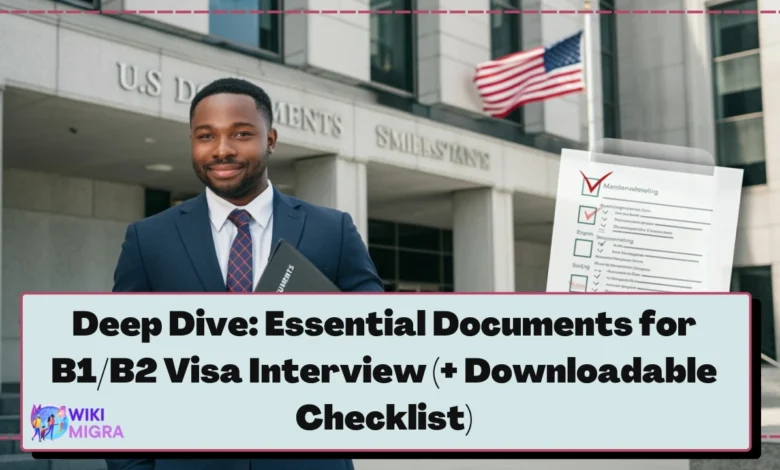
Are you gearing up for your B1/B2 visa interview in 2025? The key to success lies in having the right documents ready. This comprehensive guide delivers the ultimate checklist of documents for B1/B2 visa interview, ensuring you’re fully prepared. These documents prove your identity, intent to return home, financial capacity, and trip purpose. We’ll break them down into two main categories: Mandatory Documents (non-negotiable for everyone) and Supporting Documents (vital for proving your eligibility). Let’s dive in and get you ready to ace that interview!
Preparing for a B1/B2 visa interview can feel overwhelming, but having the correct documents for B1 B2 visa interview simplifies the process. Whether you’re applying for a B1 visa (business) or a B2 visa (tourism, family visits, or medical treatment), your paperwork tells your story to the consular officer. These documents serve four critical purposes:
- Identity: Confirming who you are.
- Non-Immigrant Intent: Showing you’ll return to your home country.
- Financial Capacity: Proving you can fund your trip.
- Trip Purpose: Validating why you’re visiting the U.S.
In this post, we’ll cover everything you need: from mandatory documents every applicant must bring to supporting documents that strengthen your case. Expect clear insights, actionable tips, and a B1/B2 visa document checklist to guide you step-by-step. Let’s get started!
Section 1: MANDATORY Documents (Non-Negotiable)
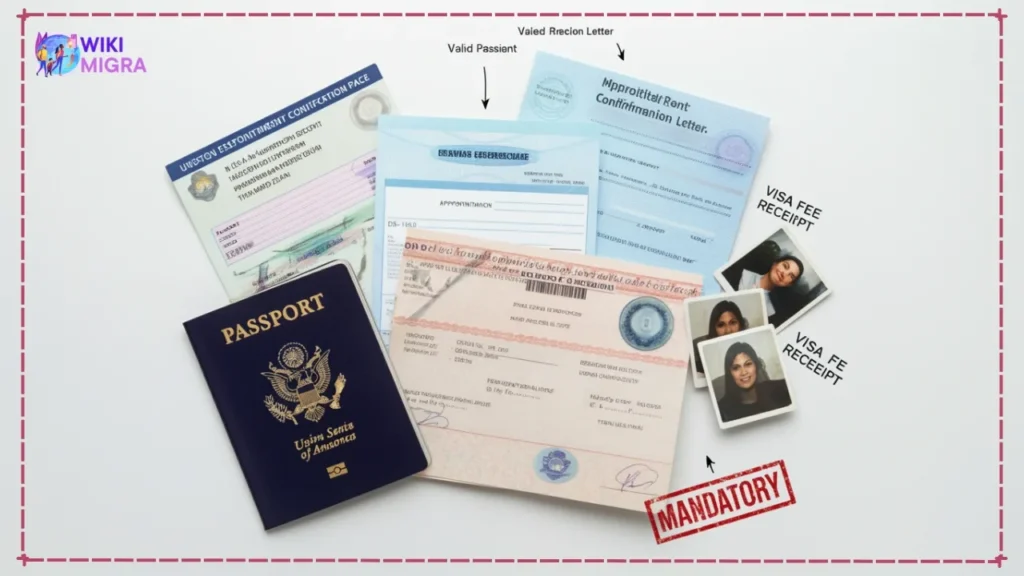
These are the mandatory documents for US visa interview that every B1/B2 applicant must present. Missing even one could derail your application. Here’s the list, with details on why each is essential:
- Valid Passport
- Requirement: Must be valid for at least six months beyond your planned U.S. stay.
- Why It’s Needed: Your passport is your primary ID for international travel and visa processing.
- DS-160 Confirmation Page
- Requirement: Print the page with the barcode after submitting your online DS-160 form.
- Why It’s Needed: Links your interview to your application, giving officers access to your details.
- Appointment Confirmation Letter
- Requirement: Printout showing your interview date, time, and location.
- Why It’s Needed: Confirms your scheduled slot and helps the consulate manage appointments.
- Visa Fee Payment Receipt
- Requirement: Proof of payment for the visa fee (typically $160).
- Why It’s Needed: Verifies that your application fee has been processed.
- Passport-Sized Photos
- Requirement: Two recent 2×2-inch photos meeting U.S. visa standards.
- Why It’s Needed: Used for your visa and records. Note: Some consulates require digital uploads only—check your specific consulate’s rules.
Quick Tip: Double-check photo specs and validity dates to avoid last-minute hiccups. These mandatory documents B1 B2 visa are your foundation—get them right!
Section 2: SUPPORTING Documents (Crucial for Proving Your Case)
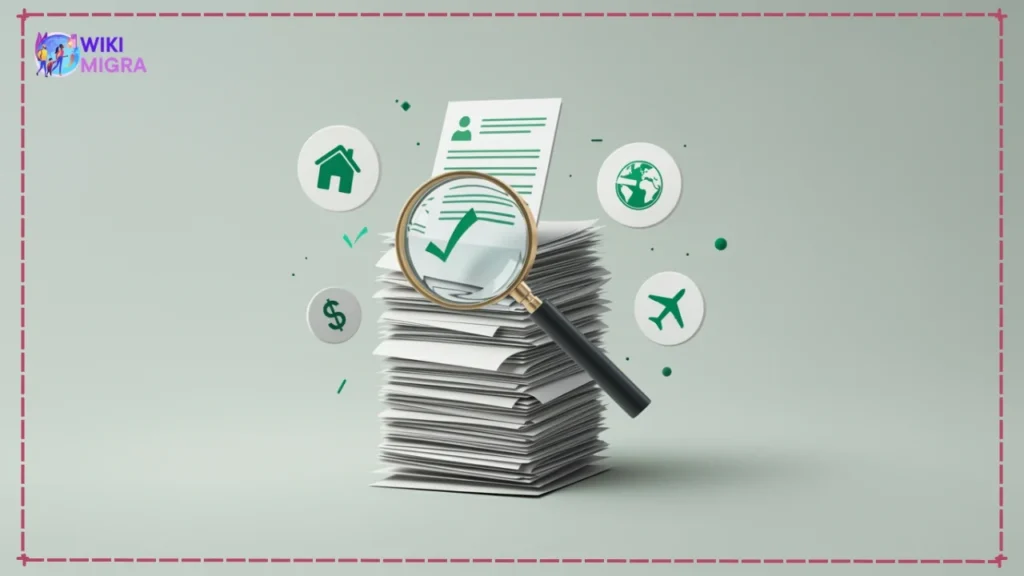
While mandatory documents get you in the door, supporting documents for B1 B2 seal the deal. They prove your eligibility by showing strong ties to your home country, financial stability, and trip purpose. Consular officers rely heavily on these to assess your non-immigrant intent. Let’s break them into clear categories.
Proof of Strong Ties to Your Home Country (MOST IMPORTANT)
Demonstrating proof of ties B1 B2 visa documents is the cornerstone of your application. It convinces officers you’ll return home after your U.S. visit. Here’s what works:
- Employment Letter
- Details your job title, salary, tenure, and approved leave. Shows you have a stable career to return to.
- Business Ownership Documents
- Registration papers, tax returns, or client contracts if you’re self-employed. Proves your business anchors you.
- Property Deeds or Rental Agreements
- Ownership or a long-term lease ties you to your home country physically.
- Family Certificates
- Marriage or birth certificates of dependents highlight family responsibilities.
- School Enrollment Letter
- For students, confirms your studies and return date.
For Self-Employed: Include business registration, tax returns, and contracts. The more evidence, the better—tailor it to your life!
Proof of Financial Stability / Funding for Trip
Showing you can afford your trip—and have stable finances to return to—is key. These financial documents for visa interview include:
- Recent Bank Statements
- 3-6 months of statements showing consistent activity (not just a big deposit).
- Salary Slips
- Recent pay stubs verifying your income.
- Tax Returns
- Past 1-2 years to establish financial history.
- Letter from Employer
- Reconfirms your salary and job stability.
If Sponsored
If someone’s funding you, add:
- Affidavit of Support (Form I-134)
- Your sponsor’s commitment to cover your costs.
- Sponsor’s Proof of Status
- Their passport, green card, or visa copy.
- Sponsor’s Financial Documents
- Bank statements, tax returns, employment letter proving they can support you.
Key Note: Authenticity matters—fake documents are a fast track to rejection.
Proof of Trip Purpose
Your documents must match the purpose stated in your DS-160. Here’s what to bring based on your visa type:
For B2 (Tourism, Family Visit, Medical)
- Detailed Travel Itinerary
- Outline your plans, destinations, and stay duration.
- Hotel Bookings
- Confirmation if you’ve reserved lodging.
- Invitation Letter
- From U.S.-based family/friends, including their status (e.g., citizen, resident).
- Doctor’s Letter
- For medical trips, include your condition and U.S. appointment details.
For B1 (Business)
- Letter from Employer
- Explains your trip’s business purpose (e.g., meetings, training).
- Invitation Letter from U.S. Company
- Formal invite from your U.S. business contact.
- Conference Registration
- Proof of attendance if applicable.
- Correspondence with U.S. Contacts
- Emails or letters showing your business ties.
Pro Tip: Consistency is critical—ensure these align with your application.
Other Potentially Useful Documents
- Previous Passports
- Show travel history and visa compliance.
- Police Clearance Certificate
- Only if requested by the consulate.
- Resume/CV
- Useful for B1 applicants to highlight professional background.
Section 3: How to Organize Your Documents
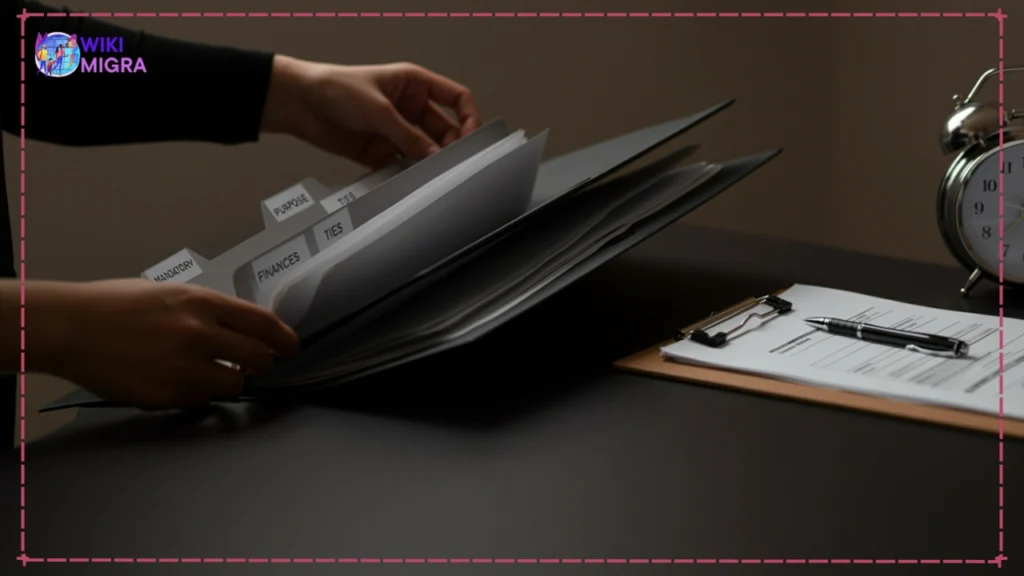
Got your documents for B1 B2 visa interview ready? Now, organize them like a pro. A tidy presentation impresses officers and saves time. Here’s how:
- Use a Sturdy Folder
- Keep papers safe and professional-looking.
- Order Smartly
- Mandatory documents first, then supporting docs in categories: Ties, Finances, Purpose.
- Add Clips or Dividers
- Separate sections for quick access.
- Originals vs. Copies
- Bring originals but offer copies unless asked otherwise (check consulate rules).
- Know Your Stuff
- Memorize where each document is for smooth retrieval.
Example: Picture this—your officer asks for your employment letter, and you flip right to it. Confidence boost! Mastering how to organize visa documents sets you apart.
Section 4: Downloadable B1/B2 Document Checklist (PDF)
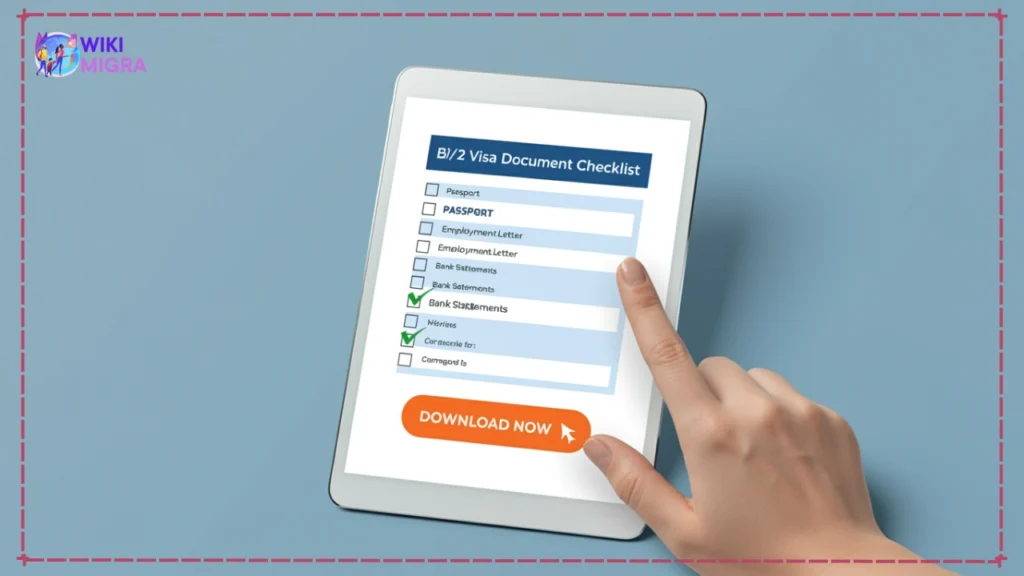
Want a handy summary? Grab our free B1 B2 visa document checklist in PDF form. It lists all mandatory and supporting documents with checkboxes to track your progress.
Download Your Free Checklist Here
Section 5: Key Reminders & Common Mistakes
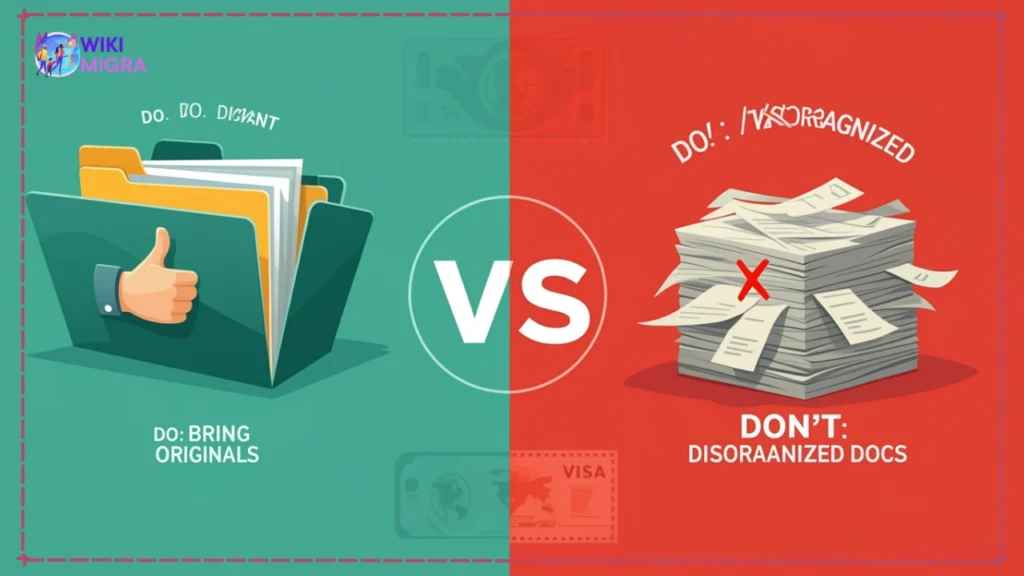
Before you head to the consulate, keep these in mind:
Reminders
- Bring Originals: Unless specified, originals are safest.
- Stay Current: Expired or outdated docs won’t cut it.
- No Fraud: Fake documents lead to permanent bans.
Common Mistakes
- Forgetting mandatory documents B1 B2 visa like the DS-160 confirmation.
- Weak proof of ties B1 B2 visa documents—don’t skimp here!
- Handing over a messy stack—organization matters.
Real Talk: One applicant forgot their visa fee receipt and had to reschedule. Don’t be that person!
Steps to Increase Your Chances of Getting a B1/B2 Visa
- Prove Strong Ties to Your Home Country: Provide evidence of strong ties, such as stable employment, property ownership, family responsibilities, or community involvement. These demonstrate your intent to return home after your visit.
- Prepare a Detailed Travel Itinerary: Clearly outline the purpose of your trip with specific dates and locations. Include supporting documents like event invitations, hotel reservations, or tickets for planned activities.
- Demonstrate Financial Capability: Show proof that you can afford the trip by providing bank statements, pay stubs, or sponsorship letters if someone else is covering your expenses.
- Be Honest and Consistent in Your Application: Ensure all information in your application and interview aligns. Any inconsistencies may raise red flags and lead to denial.
- Practice for the Visa Interview: Prepare clear answers about your travel purpose, financial situation, and ties to your home country. Dress professionally and maintain a respectful demeanor during the interview.
- Avoid Common Pitfalls: Do not provide incomplete applications or false information. Ensure all required documents are submitted accurately.
- Highlight Previous Travel History (if applicable): If you have traveled internationally without overstaying visas in the past, mention this as it shows compliance with visa rules.
Requirements for a B1/B2 Visa at the U.S. Embassy
To apply for a B1/B2 visa at the U.S. Embassy, applicants must meet specific requirements and provide necessary documentation. Below are the steps and requirements:
1. Purpose of Travel
Applicants must demonstrate that their visit to the United States is temporary and falls under one of these categories:
- B1 Visa: Business purposes such as attending conferences, negotiating contracts, or consulting with business associates.
- B2 Visa: Tourism, visiting family or friends, medical treatment, or participation in social events.
2. Proof of Financial Means
Applicants must show evidence of sufficient funds to cover travel expenses during their stay in the U.S., such as:
- Bank statements
- Proof of income
- Sponsorship letters (if applicable)
3. Ties to Home Country
Applicants need to prove strong ties to their home country to ensure they will return after their visit. Examples include:
- Employment verification
- Property ownership
- Family relationships
4. Valid Passport
A passport valid for at least six months beyond the intended stay in the U.S.
5. Completed Form DS-160
The DS-160 Nonimmigrant Visa Application form must be completed online, and the confirmation page must be printed for submission.
6. Visa Fee Payment
Pay the non-refundable visa application fee of $185 (as of May 2023) and retain proof of payment.
7. Photograph
A recent passport-style photograph meeting U.S. government guidelines.
8. Interview Appointment
Schedule an interview at a U.S. Embassy or Consulate and bring:
- Confirmation page from Form DS-160
- Appointment confirmation letter
9. Additional Supporting Documents
Depending on the purpose of travel, additional documents may include:
- Invitation letters (for business or personal visits)
- Medical diagnosis and treatment plan (for medical purposes)
- Travel itinerary
Note: Applicants aged between 14–79 generally require an interview unless eligible for an Interview Waiver Program.
Section 6: Official Resources & Disclaimer
For the latest info, check these trusted sources:
Disclaimer: This guide offers general advice, not legal counsel. Visa rules can shift—verify with your consulate for 2025 specifics.
Bank Statement Requirement for a US Tourist Visa
To determine how many months of bank statements are required for a US tourist visa, it is essential to analyze the guidelines provided by authoritative sources and understand the expectations of US consular officers during the visa application process.
Importance of Financial Proof
When applying for a US tourist visa (B-2 visa), applicants must demonstrate that they have sufficient financial resources to cover their travel expenses, accommodation, and other costs during their stay in the United States. This financial proof is typically provided through bank statements, which help establish the applicant’s financial stability and ability to fund their trip without seeking unauthorized employment or overstaying.
Standard Requirement for Bank Statements
US consulates generally require applicants to submit bank statements covering the last 3 to 6 months as part of their financial documentation. These statements provide evidence of consistent income, savings, and spending patterns, which are critical in assessing an applicant’s financial reliability.
Why 3 to 6 Months?
The requirement for 3 to 6 months of bank statements ensures that:
- The applicant has a stable source of income.
- There are no sudden large deposits that might raise suspicion about misrepresentation.
- The account reflects regular transactions consistent with the applicant’s declared income and lifestyle.
For example:
- If you are employed, your salary deposits over this period should align with your pay slips or tax returns.
- If you own a business, your account should show steady inflows from business operations.
Exceptions and Additional Considerations
While 3 to 6 months is the standard guideline:
- Applicants who rely on sponsorship may need to provide their sponsor’s financial documents instead (e.g., sponsor’s bank statement for the same period).
- Consular officers may not always request these documents but having them ready strengthens your case.
- Other supporting documents like fixed deposits, property ownership records, or investment certificates can supplement your bank statements if needed.
You will generally need to provide bank statements covering the last 3 to 6 months when applying for a US tourist visa. Ensure these statements reflect consistent income and savings without any irregularities that could raise concerns during your interview.
Conclusion
Nailing your B1/B2 visa interview starts with thorough document prep. This ultimate checklist of documents required for B1 B2 visa interview ensures you’ve got identity, intent, finances, and purpose covered. Organize them well, avoid pitfalls, and walk in confidently. For more prep tips, check our B1 B2 Visa Interview Guide. You’ve got this—good luck!




